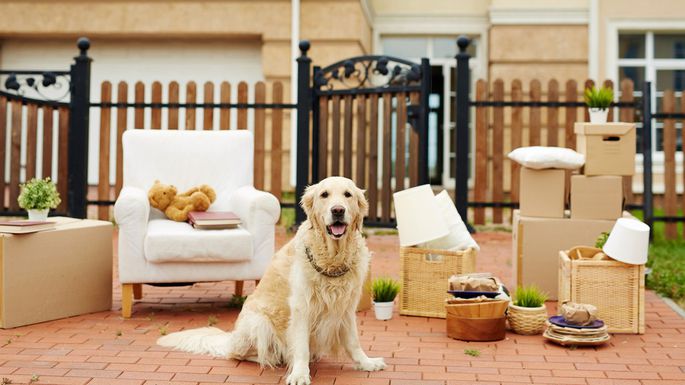Pets are part of the family and when it comes to moving, pet owners make their dogs’ and cats’ needs a priority and also navigate a move with their pets in mind. Whether you’re moving to an apartment down the street or relocating across the country, planning for a move is a big and daunting task. It is very important to understand the reason behind your move. Whether it’s a pet-friendly house or larger square footage, your motivations for moving are a deciding factor in the home you purchase or move to. Pets can feel unsure about their situation due to their changed routines. When you move with pets, their scenery and smells change which signals distress for your fur baby. Don’t forget that you are your pet’s most familiar and favorite anchor especially in the new home. If they are acting timid, unsure or following you around all the time, you may need to be patient with them. You need to remain calm and consistent during all this time. You can follow the tips given below to help make this transition as smooth as possible for your pup:
Pets are part of the family. So when it comes time to buy a home, pet owners make their dogs’ and cats’ needs a priority. But what, exactly, makes a pet-friendly home? This buying and moving guide will help you navigate a move with your pets in mind.
Table of Contents
Tips On Pet-Friendly Features Of Your New Home
A pet-friendly home makes it easy for dogs and cats so you can keep the following point in mind while choosing a home for your next move.
- Hard flooring should be preferred.
- The single-story floor plan is favorable
- Carpet runners on stairs are suggested for senior dogs.
- Prefer fenced backyard
- Mudrooms
- Look for safe sidewalks and pedestrian crossings
- Nearby parks, trails, and green spaces are recommended.
Before The Move Tips
Your pets can sense that something is up before the move. On seeing you packing boxes and bags, they can sense your mood. They can even sense if you’re anxious or stressed about the impending move. You can make your pet feel at ease by following the tips below:
- Spend some quality time with your pet before the move so that they are focused on you. You can reinforce basic obedience commands if your pet is a dog, so they are fresh in their mind.
- You should prefer spraying a distinct scent around your home starting three weeks before you move and spray this same smell in the new house before your pet arrives, it will give them a homely feeling at the new place.
- Don’t forget to check your new house for any poisonous or hazardous items like rat poisoning/traps, holes in the fence or chew able objects to keep your pets safe.
- Research and arrange a veterinarian to have on call in the new city if you are moving cities just in case you need them.
- Get or update the license of your pet according to local ordinances, update their identification tags and contact your pet’s microchip or tattoo registry to update your contact information. These are very important papers.
- Check the local law if you are moving cities and find out if you need a new license. Know the leash laws and if there are any ban on a particular pet breed in your new city.
- You can condition your pet by having a few boxes and suitcases out ahead of time and before the move as they don’t associate those objects with you leaving.
During the Move Tips:
Keeping your pet safe and calm on moving day should be utmost important as many pets run away during relocation’s and never find their way home. You can avoid this happening to your beloved pet and make your move a lot more enjoyable for them by keeping the following tips in mind.
- You can keep your pet busy with toys during busy packing activities to keep them occupied in their crates.
- You can ask a friend to help to watch your pet to keep them away from the hustle and bustle of moving.
- Keep your pets at a safe place as your pet may become scared when the moving boxes start to take over. Ensure they don’t run out the door, don’t get lost or hurt by keeping them in their safe space.
- Keep your dog tagged during the move. Make sure your pet has proper identification and tags on, just in case they get out.
- Get all their medication done especially if your pet gets anxiety during the move, consider a veterinarian prescribed anti-anxiety medication or thunder shirt.
- Be sure not to over-feed them on a moving day, especially if they will be in the car for long periods of time.
After the Move Tips:
It is very important to make your dog or cat, feel like they are home, too after the move. Your pet may have about abandonment or unfamiliarity at the new place and you can do many things around your new place to ease any fears they possess. You can show non-verbal signals to make them feel that they are safe, loved and a permanent part of your new home.
- Let your pet acquainted with their new space. Take your dog for a leashed walk inside and outside to let them get acquainted with the new smells while they’re feeling safe when you get to the new home.
- If you have cats as a pet then introduce them to one room at a time when you get to your new home. Confine them to one room at first and then slowly introduce the rest of the house.
- Make them feel at home by placing your pet’s bowls, bed, and leash in the same room in the new house as they were in the old house.
- You should stick around your house for a few days initially. You can plan to be home with your pet the first few days after the move. Start by leaving them in a house for short periods of time to see how they react. This is required so that when you need to be away from the house all day or longer periods, your pet will feel more comfortable.
- In the beginning, leave treats and familiar toys with your pet when you depart the house.
- Spend time with them on the floor with your pets. Literally, get on their level as this will not only give them personal attention but will help your scent sink into the floor faster which will make them more comfortable.
- Most importantly, observe your pet’s behavior and watch out for any problematic signs. If they show any signs of stress like refusing to eat, coughing or diarrhoea, take them to the vet without delay.
- Keep your daily routine as close and consistent as possible to the way it was before the move. Activities of your pet including feeding walks, and playtime and cuddle time should happen at the same time as before.
Your pets are an integral part of your family and moving them safe during a house move is equally important. Before moving to Los Angeles California, you must hire a reliable mover and discuss your pet moving requirements.




